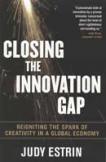Ahead, or Keeping Pace?
Judy Estrin is clearly a brilliant and accomplished woman. She is a serious technologist who has co-founded seven tech companies, one of which was purchased by Cisco Systems, the leading provider of Internet infrastructure hardware. She then rose to become chief technology officer of Cisco, one of the half dozen most important technology jobs in the world.
She has also written an utterly vacuous book on the “innovation gap.” But that says more about the inanity of most business book publishing than about Estrin, for it is fairly typical of the pap that clogs the business book shelves.
What is the “innovation gap”? Estrin never says. Other than assuming it in her title, she provides not a shred of evidence that it exists.
In fact, it is an interesting and difficult question. Study groups often propose proxy measures, like number of patents issued, but they are notoriously unreliable. There were alarms over a “patent gap” with Japan in the 1980s, for instance, but it was an illusion—Japanese companies tend to file a multiplicity of patents on the same technology.
The hysteria over the Japanese technology threat peaked precisely at the time that Americans were racing ahead of the rest of the world in the technologies that were at the root of the computer and communications revolution of the 1990s, especially microprocessor-based computing and the Internet. A similar scare, absent any confirming data, has arisen about an alleged innovation threat from China and India.
The history of technological innovation suggests that it proceeds in fits and starts, rather than in a smooth glide. Innovative bursts build on specific enabling technologies, like the railroads and telegraph. (They were symbiotic technologies. Railroads provided the rights of way for telegraph lines, and their station masters were the operators, while the telegraph allowed railroads to track their far-flung rolling stock.) Other enabling technologies, mostly pioneered in the United States, include the machining of standardized parts, a precondition of mass consumer production; electricity, which allowed the decentralization of industry; digital processing; and most recently the Web and the Internet.
There is no consistent pattern of government versus private sector initiative in those examples. Most countries recognized the opportunities in railroads and the telegraph early on, and both were heavily subsidized everywhere. The government was also heavily involved in the advance of 19th-century machining technology through arms procurement, but its spread into the private sector was a long, gradual process. Electricity was powerfully advanced by private-sector companies like Edison’s and Westinghouse’s, while the Internet and its core supporting technologies were developed almost solely on the government’s dime. Private companies like I.B.M. and Microsoft resisted adoption of the Internet until they were shouted into submission by the geek community.
There are clear stages in all those examples: an extended and relatively invisible development of a core technology, followed by a burst of headline-grabbing innovation as it achieves critical mass and, finally, a period of consolidation and standardization. Plausibly, perceptions of an “innovation gap” will differ dramatically depending on what stage of a cycle we are in.
Estrin, however, has nothing to say about such things. Instead, in the style of most business books, she starts with a set of mantras for a culture of innovation: “questioning, risk-taking, openness, patience, and trust.” (The same mantras might work for a book on marriage counseling.) She then proceeds to cite a grab-bag of successful innovations that arguably demonstrate one or the other mantra. She would like to see more “superb teachers to inspire and inform the next generation”; she likes charter schools, wants more government spending on research (the United States spends far more than any other nation); thinks we should reduce regulation of industry; and, quite correctly, argues that it is dumb to restrict visas and work permits for talented scientists, as our security apparatus is currently doing. One is amazed that 200 pages and more could be occupied by such anodynes.
Estrin does stress the importance of stocking industry and government with well-qualified scientists. That is clearly an issue of national importance, but she has no numbers to bound the extent of the problem. It took me only a half hour or so to track them down, and I found them surprising. According to the National Science Foundation, between 1993 and 2003, the year of the most recent census, the number of Ph.D. scientists employed in the fields of their specialization grew by 172,000, or by about a third.
There has also been a pronounced shift toward the harder sciences. Ph.D.’s employed in “soft,” or possibly ersatz, sciences like economics and sociology, dropped fairly sharply. Mathematicians and statisticians, however, are up by 37 percent; computer and information scientists have more than doubled; physicists and astronomers have increased by 20 percent and Ph.D. engineers by 44 percent.
In today’s world, maintaining competitiveness in core sciences is of crucial importance. Do we have an innovation gap? Are we falling behind or keeping pace? The N.S.F. numbers look rather positive, but what should we be comparing them against? These are important and difficult questions, but Estrin’s book sheds no light on the subject one way or the other.
This article also appeared in print, under the headline “Ahead, or Keeping Pace?,” in the February 9, 2009, issue.








